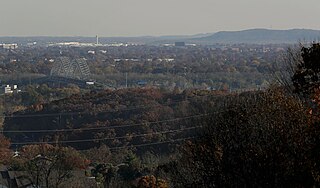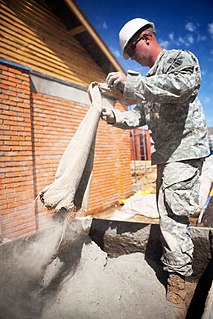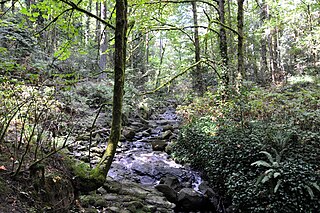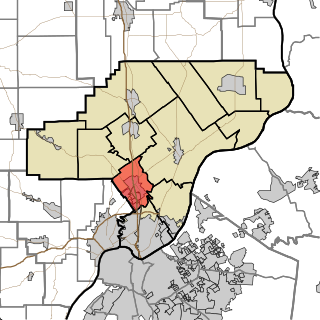| Silver Creek | |
|---|---|
Silver Creek, by Lapping Park | |
| Country | US |
| Physical characteristics | |
| River mouth | Ohio River |
| Length | 38 miles (61 km) |
| Basin features | |
| Basin size | 97,442 acres (394.33 km2) |
Silver Creek is a stream in southern Indiana in the United States. It drains a watershed of 97,442 acres (394.33 km2). [1] The creek rises in Scott County and flows 38.0 miles (61.2 km), [2] dropping 168 feet (51 m), before flowing into the Ohio River.

A stream is a body of water with surface water flowing within the bed and banks of a channel. The stream encompasses surface and groundwater fluxes that respond to geological, geomorphological, hydrological and biotic controls.

Indiana is a U.S. state located in the Midwestern and Great Lakes regions of North America. Indiana is the 38th largest by area and the 17th most populous of the 50 United States. Its capital and largest city is Indianapolis. Indiana was admitted to the United States as the 19th U.S. state on December 11, 1816. Indiana borders Lake Michigan to the northwest, Michigan to the north, Ohio to the east, Kentucky to the south and southeast, and Illinois to the west.

The United States of America (USA), commonly known as the United States or America, is a country composed of 50 states, a federal district, five major self-governing territories, and various possessions. At 3.8 million square miles, the United States is the world's third or fourth largest country by total area and is slightly smaller than the entire continent of Europe's 3.9 million square miles. With a population of over 327 million people, the U.S. is the third most populous country. The capital is Washington, D.C., and the largest city by population is New York. Forty-eight states and the capital's federal district are contiguous in North America between Canada and Mexico. The State of Alaska is in the northwest corner of North America, bordered by Canada to the east and across the Bering Strait from Russia to the west. The State of Hawaii is an archipelago in the mid-Pacific Ocean. The U.S. territories are scattered about the Pacific Ocean and the Caribbean Sea, stretching across nine official time zones. The extremely diverse geography, climate, and wildlife of the United States make it one of the world's 17 megadiverse countries.
It forms the boundary between Clark and Floyd counties. The stream was called Silver Creek by the time it was part of land granted to George Rogers Clark, who lived in a log cabin near the creek's mouth. [3] It was named Silver Creek due to a rumor that silver treasure was hidden by creek, and that silver ore could be found. [4] [5]

Clark County is a county located in the U.S. state of Indiana, located directly across the Ohio River from Louisville, Kentucky. At the 2010 Census, the population was 110,232. The county seat is Jeffersonville.

Floyd County is a county located in the U.S. state of Indiana. As of 2012, the population was 75,283. The county seat is New Albany. Floyd County is the county with the second-smallest land area in the entire state. It was formed in the year 1819 from neighboring Clark, and Harrison counties.

George Rogers Clark was an American surveyor, soldier, and militia officer from Virginia who became the highest ranking American military officer on the northwestern frontier during the American Revolutionary War. He served as leader of the militia in Kentucky throughout much of the war. He is best known for his celebrated captures of Kaskaskia (1778) and Vincennes (1779) during the Illinois Campaign, which greatly weakened British influence in the Northwest Territory. The British ceded the entire Northwest Territory to the United States in the 1783 Treaty of Paris, and Clark has often been hailed as the "Conqueror of the Old Northwest".
At the mouth of the creek was the first cement operation in Indiana, at Beach's Mill in 1830. [6]

A cement is a binder, a substance used for construction that sets, hardens, and adheres to other materials to bind them together. Cement is seldom used on its own, but rather to bind sand and gravel (aggregate) together. Cement mixed with fine aggregate produces mortar for masonry, or with sand and gravel, produces concrete. Cement is the most widely used material in existence and is only behind water as the planet's most-consumed resource.
The creek was the site of Shirt-Tail Bend, a popular dueling location for Kentuckians, as the practice was illegal in their state. The Silver Creek banks were the site at least four duels, including most famously one between Humphrey Marshall and Henry Clay on January 19, 1809. Both men suffered slight wounds. Marshall opposed Clay's proposal that all Kentucky legislators should wear domestic homespun rather than English broadcloth. [3]

Kentucky, officially the Commonwealth of Kentucky, is a state located in the east south-central region of the United States. Although styled as the "State of Kentucky" in the law creating it, (because in Kentucky's first constitution, the name state was used) Kentucky is one of four U.S. states constituted as a commonwealth. Originally a part of Virginia, in 1792 Kentucky became the 15th state to join the Union. Kentucky is the 37th most extensive and the 26th most populous of the 50 United States.

Henry Clay Sr. was an American attorney and statesman who represented Kentucky in both the United States Senate and United States House of Representatives, served as 7th speaker of the U.S. House of Representatives, and served as the 9th U.S. secretary of state. He received electoral votes for president in the 1824, 1832, and 1844 presidential elections and helped found both the National Republican Party and the Whig Party. For his role in defusing sectional crises, he earned the appellation of the "Great Compromiser."

Broadcloth is a dense, plain woven cloth, historically made of wool. The defining characteristic of Broadcloth is not its finished width, but the fact that it was woven much wider and then heavily milled in order to shrink it to the required width. The effect of the milling process is to draw the yarns much closer together than could be achieved in the loom and allow the individual fibres of the wool to bind together in a felting process. This results in a dense, blind face cloth with a stiff drape which is highly weather-resistant, hard wearing and capable of taking a cut edge without the need for being hemmed.

















